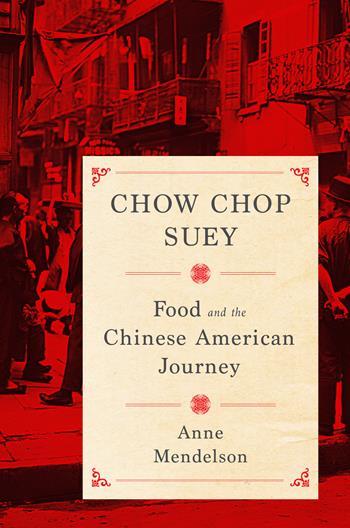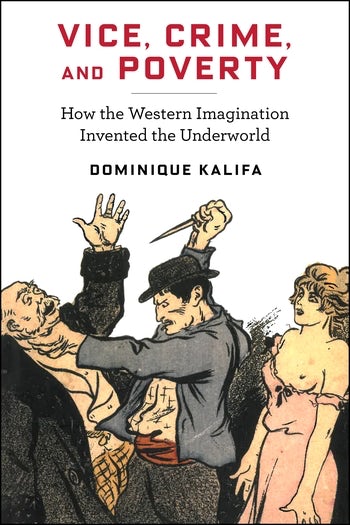The History of Chinese Food in the United States
“Wasn’t this sudden culinary coinage simply a travesty of honest Cantonese cuisine? Well, perhaps ‘travesty,’ but not ‘simply.’ The whole story is not at all simple. We would be wrongheaded to forget that chop suey and kindred inventions like American-style chow mein or foo young took on – and possess to this day — a vigorous life of their own in American culture. For more than a century they have given millions of white (and black) diners a pleasure not to be discredited by cavils about authenticity. By my lights, they represent a permanent enrichment of the American table, first accomplished by a community under siege.” — Anne Mendelson
This week, our featured book is Chow Chop Suey: Food and the Chinese American Journey, by Anne Mendelson. Today, we are pleased to present an article on the intertwined history of Chinese immigrants and Chinese food in the United States.
The History of Chinese Food in the United States
By Anne Mendelson
“Go back to China!” a white woman screamed at New York Times deputy Metro editor Michael Luo during the homestretch of the 2016 presidential election. The taunt is vicious even now. But at one time in this country it often presaged not hateful stares but either deportation proceedings or homicidal violence.
Chinese entering California in the 1850s with hopes of gold or at least jobs soon found demagogues accusing them of malignantly undermining honest white workingmen’s wages. One result was a series of federal laws allowing Chinese manual laborers to be deported, after a year’s hard labor, unless they could produce official certificates of residency. Another was an eruption of arson and lynchings during the 1870s and ‘80s, frequently sanctioned by local authorities.
Cantonese-born fugitives from murderous xenophobia in the Far West not only founded the Chinatowns of the Midwest and the Eastern seaboard, but managed to invent an unexpected culinary novelty that white people called by the garbled name “chop suey.” For all its ignominious modern reputation, chop suey represented a pioneering gambit in American racial politics. It turned to surprising account a hated minority’s reputation as fine cooks.
One of the few things agreed on by both hostile and friendly Westerners was that, as an English newspaper correspondent stationed in China declared in 1857, “Every Chinaman has a natural aptitude for cookery.” A phenomenal talent for cooking to please white employers had earned Chinese men a niche as household servants even in Sinophobic California. Meanwhile, they cooked for themselves with great skill whenever possible, drawing on a supply network of ingredients imported from Hong Kong to San Francisco and later New York.
Refugees from lynch mobs began settling in New York’s old Five Points district at around 1870 and promptly founded restaurants serving Cantonese cuisine, widely regarded as China’s finest. Some white New Yorkers were intrigued enough to become regular chopstick-wielders at these eateries by the late 1880s.
Within a decade, the Chinese struck gold by carefully reading the dominant race’s preferences. They improvised an ingenious marriage between Cantonese-style stir-fried dishes and some striking effects inspired by their prior experience in cooking for white people. The winning formulas depended on plenty of sugar in glossy, starch-thickened sauces liberally laced with soy sauce and browning agents. The idea was to imitate roux-bound gravy from a Western-style roast while introducing supposedly “Oriental” touches.
White patrons joyously devoured the new dishes under such names as “chicken chop suey,” “beef chop suey,” or “shrimp chop suey.” These jumbled labels reflect linguistic cross-purposes. The Chinese characters for the same items indicate “chao [stir-fried] chicken,” “chao beef,” and so forth. But the English term “stir-fry” did not yet exist. The technique was unintelligible to people who had never seen the workings of a Chinese kitchen. Encountering the romanization “chow chop suey” (“chao mixed bits”) for a dish of stir-fried innards and offal, somebody cluelessly latched onto the last two words and ended up baptizing America’s first nationwide ethnic-crossover food craze.
With unerring instinct, Chinese restaurant cooks had fashioned a cuisine that appeared exotic and adventurous to the target audience while staying safely within a middlebrow white American frame of culinary-cultural reference. The combination of very rapidly prepared food – stir-frying is the ideal short-order cooking method – with atmospheric décor featuring Chinese lanterns or dragon motifs was an instant draw.
“Chop suey” caught on from coast to coast with a speed made possible by the new miracle of wire services distributing syndicated copy from big-city newspapers to the boondocks. By 1910 it was well on its way to being the stock-in-trade of Chinese restaurants in every metropolis, small city, and large town throughout the contiguous United States.
Wasn’t this sudden culinary coinage simply a travesty of honest Cantonese cuisine? Well, perhaps “travesty,” but not “simply.” The whole story is not at all simple. We would be wrongheaded to forget that chop suey and kindred inventions like American-style chow mein or foo young took on – and possess to this day — a vigorous life of their own in American culture. For more than a century they have given millions of white (and black) diners a pleasure not to be discredited by cavils about authenticity. By my lights, they represent a permanent enrichment of the American table, first accomplished by a community under siege.
At the height of “Go back to China!” rabble-rousing cloaked in the mantle of patriotic support for jobless native-born workers, an undaunted segment of the despised Chinese community in America responded by reaching across racial divides through the medium of food. The chop suey-style cuisine that it created may be more resoundingly American than Delmonico’s, the Golden Arches, or Trump Grill.



